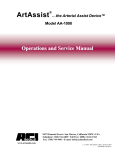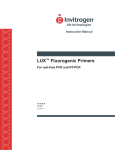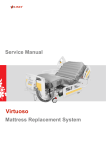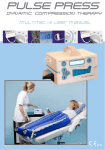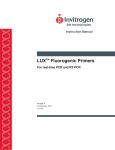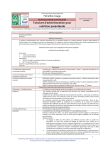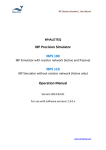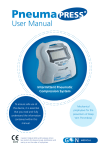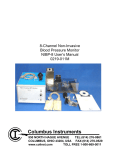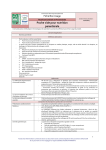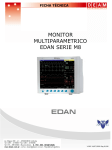Download Kendall SCD EXPRESS Frequently Asked Questions
Transcript
Kendall SCD EXPRESS™ Compression System Controller - Frequently Asked Questions Question Answer HOW DID THE SCD EXPRESS™ COMPRESSION SYSTEM COME TO BE? Kendall’s Vascular Therapy Research & Development group is constantly looking for ways to improve the existing systems such that to continue to raise the standard of care for patients. Kendall Vascular Therapy consulted with an outside firm to conduct Voice of the Customer (VOC) interviews and Focus Group sessions to identify the true needs of the clinical community. Physicians and nurses from areas throughout the United States participated in group-sessions to candidly discuss their concerns and needs. Various concepts and design possibilities were presented to our Focus Groups after lengthy discussions of what each clinician liked and disliked about mechanical compression. The result of our VOC efforts is the SCD EXPRESS™ Compression System. DOES THE SYSTEM STILL DELIVER THE SAME CLINICALLY PROVEN COMPRESSION TO THE LEG (45 MMHG)? The SCD EXPRESS™ Compression System uses the same clinically proven compression parameters as all previous SCD™ Compression System controllers. The eleven-second-compression cycle is microprocessorcontrolled to ensure 45mmHg-pressure delivery at the ankle, with resulting pressures of 40 mmHg and 30 mmHg respectively at the calf and thigh areas. The customized vent time provides each individual patient with compression as soon as possible and as often as necessary to minimize stasis. DOES THE SCD EXPRESS™ COMPRESSION SYSTEM WORK WITH ALL SLEEVES? No. The SCD EXPRESS™ Compression System was designed to work with a new bladder design. The SCD EXPRESS™ controller will operate the SCD EXPRESS™ Compression System family of disposable sleeves and foot cuffs. DO THE SCD EXPRESS™ COMPRESSION SLEEVES WORK WITH OLDER SCD™ COMPRESSION SYSTEM CONTROLLERS? This question requires two different replies: YES – The SCD EXPRESS™ Compression System disposable sleeves will work with older SCD™ Compression System controllers provided the appropriate “backward compatible” tubing set is used. Model # 7325 SCD RESPONSE™ Compression System & 6325 SCD SEQUEL™ Compression System controllers will need item code #9918 to accommodate the SCD EXPRESS™ Compression System sleeves. Model # 5325 SCD™ Compression System will need item code #9508 to accommodate the SCD EXPRESS™ Compression System sleeves. NO – The SCD EXPRESS™ Compression System disposable Foot Cuffs will NOT work with older SCD™ Compression System controllers. CAN I USE ONLY ONE SLEEVE OR FOOT CUFF? Yes, the SCD EXPRESS™ Compression System has a new process, "Verification Mode", that allows the clinician to verify that the garments applied to the patient are, in fact, what the controller is set to operate. "Verification Mode" confirms, through user input, the required prophylaxis is being applied to the patient to ensure compliance and patient safety. If one channel is connected to the system, it will operate the one connection without alarming. ARE THERE ANY "SPECIAL" BUTTONS I WILL NEED TO PUSH TO ACTIVATE THE SYSTEM? The SCD EXPRESS™ Compression System model #9525 controller is a simple to use device. One button is used to Power-On the system. The SCD EXPRESS™ Compression System will run through a diagnostic test of the internal systems and then conduct "Verification Mode". The programming of the SCD EXPRESS™ Compression System is designed to default to leg compression or it will identify a foot garment, alert the user and request verification that foot compression is used by simply depressing the correct configuration button on Port A or B, then foot compression will begin. WHAT TYPE OF BATTERY DOES THE SCD EXPRESS™ COMPRESSION SYSTEM USE? The SCD EXPRESS™ Compression System contains a custom Lithium Ion Battery. The amount of time required to charge the battery may take between four (4) HOW LONG DOES IT TAKE TO and eight (8) hours. This may vary depending on the following: 1) The system RECHARGE THE BATTERY IN will recharge quicker if it is on standby versus system “on” or compressing. 2) THE SCD EXPRESS™ If the battery has been used frequently versus new, this may affect recharge CONTROLLER? times. 3) The battery age may affect recharge times. HOW LONG CAN THE SCD EXPRESS™ CONTROLLER OPERATE ON BATTERY POWER? The SCD EXPRESS™ Compression system can run on battery operation for about eight (8) hours. This may vary depending on the following: 1) A leg garment will use more battery power then a foot cuff. 2) Using two garments will use more battery power then one. 3) An older used battery may not last as long as a newer battery. WHAT IS THE EXPECTED LIFE Under the conditions of “normal” usage, the Lithium-Ion battery will have a life SPAN OF THE SCD span of about 2.5 years. EXPRESS™ BATTERY? WHAT HAPPENS IF THE BATTERY IS COMPLETELY DRAINED OF CHARGE? The SCD EXPRESS™ Compression System has a Safety-System Shutdown feature which automatically shuts down the system before the battery charges reach zero. This prevents the battery from becoming damaged. WHAT ARE THE ADVANTAGES OF LITHIUM ION BATTERIES COMPARED TO OTHER RECHARGEABLE BATTERIES? Lithium-Ion batteries have several advantages: They have a higher energy density than most other types of rechargeable batteries. This means that for the size and weight they can store more energy than other rechargeable batteries. They also operate at higher voltages than other rechargeable batteries, typically about 3.7 volts for Lithium-Ion vs. 1.2 volts for Nickel Metal Hydride (NiMH) or Nickel Cadmium (NiCd). This means a single cell LithiumIon battery provides more battery power than a multiple-cell NiMh or NiCd battery. Lithium-Ion batteries also have a lower self-discharge rate than other types of rechargeable batteries. This means that once they are charged they will retain their charge for a longer period of time. NiMH and NiCd batteries can lose anywhere from 1-5% of their battery charge per day, (depending on the storage temperature) even if they are not installed in a device. Lithium-ion batteries will retain most of their charge even after months of storage. LithiumIon batteries can be smaller, lighter, have a higher voltage and hold a charge much longer than other types of batteries. They can be recharged hundreds of times and maintain their efficiency unlike NiMH batteries that have distinct memory characteristics. WHAT IS THE KENDALL SCD EXPRESS™ SLEEVE MADE FROM? The SCD EXPRESS™ sleeve is made of a soft, lightweight, non-woven material. The soft inner & outer liners promote patient comfort and compliance. HOW DO I APPLY THE SCD EXPRESS™ SLEEVE? Application of the SCD EXPRESS™ Sleeve is simple. The sleeve has preprinted instructions on the inner liner. Lift the patient's leg and place the sleeve under the patient's leg according to the preprinted instructions. Be sure to align the open area of the SCD™ sleeve behind the knee to allow for unrestricted flow of blood through the popliteal area of the leg. Lower the patient's leg onto the sleeve. Begin wrapping the SCD™ sleeve around the patient's leg by bringing the side of the sleeve with the "loop" material up toward the top of the leg. Start at the ankle and work your way toward the thigh portion of the leg. Second, bring the "hook" section of the sleeve around to connect with the side already in position. Be sure to use the hook and loop connections and anatomical design of the sleeve to adjust the sleeve to ensure proper fit. Each pair of sleeves comes with the Instructions For Use (IFU). Please refer to the information provided there for more clarification. WHAT IS THE BENEFIT OF THE SCD EXPRESS™ KAMBIA™ SLEEVE? The SCD EXPRESS™ - KAMBIA™ sleeve is truly an "All-In-One" device. With the unique Tear-Away design, a quick turn of the proprietary connector and a fail-safe tear of the thigh portion of the sleeve convert the sleeve from a thigh length sleeve to a knee length sleeve in just seconds. The SCD EXPRESS™ - KAMBIA™ sleeve delivers the clinically-proven proximal DVT protection during the highest risk periods. This sleeve is designed to improve compliance and comfort during the lower-risk periods. And the SCD EXPRESS™ - KAMBIA™ sleeve provides cost savings by reducing the frequency of sleeve changes due to product soiling. WHY WOULD THE THIGH PORTION OF THE SCD EXPRESS™ - KAMBIA™ SLEEVE NEED TO BE REMOVED? The SCD EXPRESS™ - KAMBIA™ sleeve offers the option of tearing away the thigh portion to accommodate certain situations where removal of the thigh portion is required. These would include, but are not limited to, patient incontinence, soiling of the sleeve or patient compliance. It is recommended that all alterations to the prescribed modality for prophylaxis be confirmed by the attending physician. HOW DOES THE SCD EXPRESS™ - KAMBIA™ SLEEVE WORK? The SCD EXPRESS™ - KAMBIA™ sleeve incorporates a specially designed perforation in the sleeve material and a proprietary quick-disconnect connector. The perforations allow a clean, linear tear of the sleeve material to ensure the removal of the thigh portion and to maintain the integrity of the remaining sleeve bladders. Inside the connector is a valve specifically designed to allow air flow through the connector so that the SCD EXPRESS™ controller will not alarm. DO I NEED TO DO ANYTHING "SPECIAL" TO APPLY THE SCD EXPRESS™ - KAMBIA™ SLEEVE? No. The SCD EXPRESS™ - KAMBIA™ sleeve is applied in the same fashion as the standard SCD EXPRESS™ sleeves. Removal of the thigh portion of the SCD EXPRESS™ - KAMBIA™ sleeve is a simple process. Simply locate the blue thigh bladder tubing on the sleeve that is connected to the quick-disconnect connector. Grab the tubing fitting at the junction of the tubing and the connector, turn the tubing to disengage the "wings" on the tubing end from the quick-disconnect connector. Pull the tubing HOW DO I REMOVE THE out from the connector. Slide the blue tubing out of the tubing guide channel. THIGH PORTION OF THE SCD Next, disengage the hook & loop of the thigh portion of the sleeve and locate EXPRESS - KAMBIA™ the tabs on the sleeve material located near the connection from the calf SLEEVE? chamber to the thigh chamber of the sleeve. Using both hands, simply tear the sleeve material along the perforation provided on each side of the opening in the sleeve between the thigh and calf area. Discard the thigh portion. The valve located in the quick-disconnect connector will assure proper inflation of the remaining ankle and calf bladders. WHAT IS AIR PLETHYSMOGRAPHY (APG)? Air plethysmography (APG) was first used in the early 1960s to study relative volume changes in the lower limb in response to postural alterations and muscular exercise. In recent years, it has been widely used as a non-invasive method to evaluate patients with chronic venous insufficiency and to assess calf pump function and venous reflux. It consists of a large air bladder inflated to low pressures (approximately 6mmHg) around the patient’s calf. This low pressure insures adequate contact between the air bladder and the limb while causing minimal compression of the veins. The changes in pressure, resulting from the changes in calf girth, are detected. The relationships of these pressures (rate, max, and min) are used in the diagnosis of the patient. WHAT IS VENOUS REFILL TIME? Venous refill time is a term used to denote the time it takes for the venous system of the legs or feet to refill with blood after being compressed or manipulated in a certain manner. WHAT DOES THE “HOURGLASS” LED INDICATE? When the Hourglass LED is illuminated GREEN, the system’s Vascular Refill Detection is measuring the patient’s venous refill time. This will happen every 30 minutes. Normal operation will resume on the next cycle without any need for operator intervention. HOW MUCH MORE BLOOD WILL THE NEW SYSTEM MOVE? According to clinical testing, the SCD EXPRESS™ Compression System and the SCD RESPONSE™ Compression System were similar in their ability to enhance volume flow and velocity. Kakkos et al, 2004 (The Journal of Vascular Surgery) states that the total volume of blood expelled per hour was more favorable with the SCD EXPRESS™ Compression System device. WHY DO WE CARE ABOUT MOVING MORE BLOOD? According to Virchow’s triad, one of the main reasons for clot formation is blood stasis or pooling. If more blood is moved, more often, that means that blood is pooling for a shorter length of time and will be much less likely to form a clot. IS THIS BETTER FOR CERTAIN POPULATIONS? This method of compressing the legs more frequently may provide additional protection to high risk patents, where they may have shorter refill times because of valve incompetence, or they can benefit from the blood moving frequently and possibly being less likely to clot. WHAT DETERMINES A PATIENT’S REFILL TIME? Various physiological factors affect a patient’s refill time including, but not limited to, valve competency, heart stroke volume and strength, proximity of the veins to the arteries and arterial blood flow. CAN THE VASCULAR REFILL DETECTION WORK IF THE PATIENT IS ON A CPM MACHINE? The system is designed to monitor the expansion of the lower limb to determine venous refilling. However, the movement of the CPM device may influence the ability of the SCD EXPRESS™ Compression System to accurately measure the venous refill. In order to provide the patient with efficacious prophylaxis, the SCD RESPONSE™ Compression System will default to a 60-second time between compressions when extended refill measurements are detected. The venous refill time determination will be made after the microprocessor has successfully achieved 45mmHg pressure at the ankle (typically 2-3 CAN THE VASCULAR REFILL cycles). In order to accommodate the patient as they move from one position DETECTION WORK IF THE to another, the system will re-evaluate the refill time every thirty cycles to PATIENT IS MOVING AROUND reset the cycle time if needed. The SCD RESPONSE™ Compression System A LOT? will default to either 20-seconds, if a rapid refill time (less than 20 seconds) is recorded, or a 60-second refill time, if an extended refill time is monitored. ARE THERE ANY EXTRA TESTS THAT THE BIO-MEDS WILL NEED TO PERFORM FOR ROUTINE MAINTENANCE? A complete Operation and Service Manual is provided with every SCD EXPRESS™ Compression System controller. Battery re-charging takes place any time the device is plugged into an electrical outlet. Please refer to the Operation and Service Manual for more details. HOW DOES THE SCD EXPRESS™ COMPRESSION SYSTEM WITH VASCULAR REFILL DETECTION WORK? After the normal 11-second compression cycle compresses the patient’s leg, the venous refill time will be determined during the vent portion of the cycle. At the end of compression, the ankle and thigh bladders will completely deflate while the calf chamber is deflated until the pressure falls to 6mmHg (enough pressure to cause the bladder to remain in contact with the leg) and then held. The pressure in the calf bladder is then monitored for the next 60 seconds to evaluate changes in the girth of the calf. The point at which the pressure reaches a plateau (the pressure has not raised more than 0.20mmHg for 10 seconds) is considered the point at which the venous system in the legs has refilled. However, if the plateau is reached in less than 20 seconds after compression is applied, 20 seconds will be used as the vent time for subsequent cycles. Likewise, if a plateau has not been found within the sixty second measurement period, 60 seconds will be used as the subsequent vent time. The venous refill time determination will be made after the microprocessor has successfully achieved 45mmHg pressure at the ankle (typically 2-3 cycles). The system will then re-evaluate the refill time every thirty minutes to reset the cycle time, if needed, to accommodate movement or changes in the patient's position. DOES VASCULAR REFILL Yes, the SCD EXPRESS™ Compression System has also been successfully DETECTION WORK WITH THE tested with the sterile sleeve (Item #9736) and the extension tubing sets (Item STERILE SLEEVE OR #9595). EXTENSION TUBING? WILL VASCULAR REFILL DETECTION WORK WITH “KNOCK OFF” OR REPROCESSED SLEEVES? Kendall cannot determine if the new system will work with sleeves other than SCD™ sleeves because Kendall does not have control over their design. It is difficult to determine if the new system will work with reprocessed sleeves because the sleeves can be of varying degrees of integrity and performance. The SCD EXPRESS™ Compression System uses precise pressure differences in the air bladder to determine the venous refill time so it is recommended to use new SCD™ sleeves with the unit. IS THERE DOCUMENTATION SUPPORTING THE CLINICAL EFFICACY OF THE SCD EXPRESS™ COMPRESSION SYSTEM FOOT CUFF? Yes, there is hemodynamic support for the device. A study (Cardullo) was conducted on 10 healthy subjects to determine three things: Does refill time of the venous plexus differ from each patient? Can the SCD EXPRESS™ Compression System with Vascular Refill Detection detect any differences? Third, does it make a difference? In addition, the SCD EXPRESS™ Compression System with Vascular Refill Detection was compared to slow foot compression set at the industry standard 30-second default. The results showed that each patient did have a different venous refill time from 34 to 60 seconds with an average of 46 seconds. The SCD EXPRESS™ Compression System with Vascular Refill Detection was able to detect refill times and proved to affect peak blood flow significantly more (41%) than the industry standard 30-second default settings. DO THE SCD EXPRESS™ COMPRESSION SYSTEM FOOT CUFFS WORK WITH THE SAME TUBING SETS AS THE SCD EXPRESS™ COMPRESSION SYSTEM SLEEVES? Yes, the SCD EXPRESS™ Compression System controller comes with tubing sets that are used for both leg sleeves and foot cuffs. A separate, backward compatible, tubing set is available to connect the new SCD EXPRESS™ KAMBIA™ Compression Sleeves and SCD EXPRESS™ Compression System leg sleeves to older SCD™ Compression System model controllers (SCD RESPONSE™ Compression System #7325 and SCD SEQUEL™ Compression System #6325). These older controllers are designed to deliver sequential, gradient & circumferential compression, to multiple chambers, up to 45 mmHg, and therefore are not compatible to the SCD EXPRESS™ Compression System foot cuffs, which are single bladder, and require 130 mmHg. DO SCD EXPRESS™ COMPRESSION SYSTEM FOOT CUFFS WORK ON OLDER MODEL SCD COMPRESSION SYSTEM CONTROLLERS? No. The older model SCD™ Compression System controllers were designed to deliver sequential compression to multiple chambers, up to 45 mmHg. The SCD EXPRESS™ Compression System has newer technology that is able to provide foot & leg compression and has the ability to adjust the pressure given to each garment.






